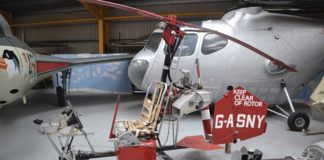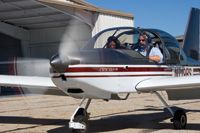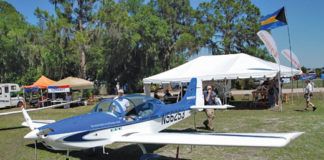There are many reasons that my husband and I didn’t build an all-composite airplane, and they are, I believe, good ones. Now, all you GlaStar and Lancair and Cozy owners might get annoyed with me about this, but my husband and I are overtly conservative when it comes to the airplanes we fly, and choosing an airplane brought all of our risk management quirks out in full force.
Although I will be the first to say that composite materials are wonderful to build with when you are trying to create machines with gorgeous aerodynamic compound curves and smooth surfaces, these materials, on their own, have flaws. For one, it is much more difficult to discover microcracks, the kind you get from fatigue, on a composite aircraft part. Sure, you can spend your days tapping with a quarter or, less likely, submit your aircraft to expensive ultrasound procedures, as the airlines and airliner manufacturers do. But lets face it: Cracks that could cause failures are harder to discover on composite aircraft than they are on metal aircraft. That was not, however, the deal killer for me.
What finally talked me out of buying a composite kit was simple: Composite aircraft do not conduct electricity the way an all-aluminum airplane does. In fact, most don’t conduct at all. Glass gliders that have been struck by lightning blew up because there was nothing to conduct the heat through the machine and out into the surrounding air. The composite material heated up and disintegrated. We know what happened because the two glider pilots in an ASK21 hit over Bedfordshire, England, on December 10, 1999, were wearing parachutes. They lived to tell about the experience.
Thunderstorms Are My Life
I live in South Florida. There are thunderstorms every afternoon for three months out of the year, and we are considered the lightning capital of the world. So I know a few things about lightning. It can strike twice in the same place (doesn’t happen often, but it can). It does strike in clear air, sometimes as far as 10 miles from an intense storm. And I know from having seen the results, that metal airplanes routinely survive. The lightning makes a hole on the way in, and a hole on the way out. It can really wreck a whisky compass by charging the airplane, and it can fry avionics, but it doesn’t hurt aircraft occupants. It doesn’t disintegrate the mainly metal machines.
When we were shopping for a kit to build (I shop, my husband does most of the building), neither of us was happy with the answers we got from manufacturers of composite kit aircraft when we asked about lightning protection. “We haven’t lost an airplane to a lightning strike,” is not the response we were looking for. A University of Florida study on lightning and aircraft performed in the late 1990s confirmed our fears again by defining the risks of lightning to aircraft built with composite materials. It also proved that aircraft sometimes caused the lightning strikes just by the friction created as they move through the clouds. It showed that airliners were struck by lightning an average of once every 10,000 hours. Yes, airliners fly IFR all the time, in and out of clouds, and their risk of a strike is huge. (It seems counterintuitive, but the worst lightning strikes are encountered between the clouds and the ground, not in the clouds.) My partner in this airplane, and its principal builder, flew airliners for 22 years.
What it came down to, for us, was the feeling that if you fly in the clouds, your chances of getting hit by lightning in an airplane are good enough that we should worry about it from a risk management standpoint. Finally, we asked our scientist and engineer friends about it, and theyd point to the glider accidents and a couple of helicopter ones, and say, “This could happen to you, too.” I know that all-composite airplanes are not falling out of the skies from lightning strikes on a regular basis, but we are worriers, and ultimately we went with the RV-10, a nearly all metal airplane, so that we would have one less thing to worry about.
Hey, What’s This?
Its a few years later, and Ive since discovered a lot of composite in my metal airplane. Its probably not enough to create a real lightning problem, especially because it is not pointy (lightning goes for sharp edges and high points, and our antennas are on metal), but its enough for me to wonder. So I read. Recently I came across a story that could make the issues around both crack detection and lightning protection for composite aircraft a moot point. In a research journal last autumn an obscure entry caught my eye. It was titled, “Using Nanotubes to Detect and Repair Cracks in Aircraft Wings.” The piece profiled the work of Rensselaer Polytechnic Institute Associate Professor Nikhil A. Koratkars Department of Mechanical, Aerospace and Nuclear Engineering Lab.
What does all this have to do with lightning? Hang in there. It comes together, and its technology you could even get your hands on today, if you had the wherewithal. Trust me.
The professor and his students Wei Zhang and Varun Sakalkar are mixing standard epoxy resins with multi-walled carbon nanotubes. Yep, nanotechnology. These electron-microscope-size particles are some of the smallest and strongest in the universe. They are, recent discoveries tell us, naturally occurring. Carbon nanotubes, it turns out, are what give Damascus steel its incredible strength and flexibility. We’ve only recently learned how carbon nanotubes naturally align themselves into ropes, bound by Van der Waals forces. And, yes, they are fabulous electrical conductors, and are even being considered for the computer chip industry.
The layups in the lab were created with a 1%, by weight, mixture of epoxy resin and carbon nanotubes, then impregnated with a very wide, extremely thin grid of wire. An ultra-low voltage current was applied through the grid, and measured. The researchers then introduced microcracks, the tiny fatigue-induced fractures that are common to composite aircraft parts that are worn, and which are undetectable by the human eye. “The electric flow was interrupted in the area of the crack in a measurable way, and we could see where the crack was, in real-time, just as it formed,” says Koratkar. The longer the crack grew, the higher the electrical resistance became at that spot in the structure.
Advance Notice
Koratkars layups could tell a pilot that there was a problem long before they failed, and allow the opportunity to land safely. But there’s more. When creating the epoxy, the professor also mixed in what he cryptically calls “a healing agent.” Koratkars students then explored what would happen if they increased the voltage running through the nanotube-impregnated layups. Eventually the voltage reached a level where the healing agent impregnated around the crack melted and oozed into the cracked area. They turned down the voltage, and as the agent cooled, it essentially “healed” the microcracks. The agent did not heal the structure 100%, ostensibly because it is softer, and has a lower melting point than the epoxy resin-carbon nanotube mixture that gives the material its rigidity and strength, but it did fix it well enough to prevent a complete failure of the part. “Real-time monitoring for composite flaws and microcracks impregnated into each structure is revolutionary,” says Koratkar. “But being able to fix it as soon as you see it? That can save lives.”
Hes right. But, of course, there’s still more. Koratkars layups are conductive, because they have carbon nanotubes and the thin wire mesh impregnated in them. Pressed, Koratkar admitted that the nanotubes alone, mixed into the epoxy, would most likely provide composite aircraft with all the lightning protection they need.
Another product, a polarized “Metal Rubber” material developed by polymer chemists at NanoSonics, an engineering lab in Blacksburg, Virginia, demonstrates how one can create conductive material from virtually any fabric, even fiberglass cloth, by repeatedly dipping the material in positively charged and then negatively charged solutions.
A combination of a conductive composite fabric and an epoxy impregnated with a small amount of multi-walled carbon nanotubes would eliminate the need for any kind of wire mesh in the composite layup that Koratkars lab has created.
The two technologies, married, could conceivably “fix” composite aircrafts flaws, in my book making them the ultimate light, safe and even superior in strength material for building all-weather aircraft.
Whats holding up the technology? Demand, says Koratkar, whose lab work was partially funded by the U.S. Army (think composite helicopter blades). “The carbon nanotubes currently cost around $300 for a pound, but that will change when there is more demand,” he assures me. “Today it is mostly research labs that use them.” Even at that price its tempting to order a few grams to mix in with a layer of gelcoat for my RV-10 wingtips, canopy and wheelpants. I mean, what can it hurt?




